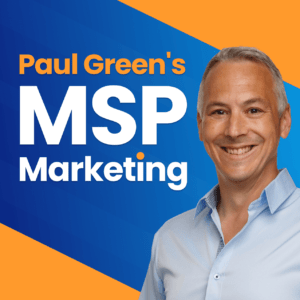
The podcast powered by the MSP Marketing Edge
Welcome to Episode 255 of the MSP Marketing Podcast with me, Paul Green. This week…
- How to minimise interruptions and stupid questions from staff: It’s important to invest time every day on growing your MSP without interruptions and I’ve got a 3 step fix to help you do just that.
- 5 big ugly MSP marketing myths: BUSTED: Improving your marketing becomes much easier when you wipe these common myths from your head. Just like IT, marketing should be logical and systemisable.
- The 3 most important growth things you can do in the final 3 months of the year: My guest this week, Ian Luckett, unveils his expert advice as a Business Growth Consultant, to achieve the most from the rest of 2024.
- Paul’s Personal Peer Group: Francis from an MSP in Washington wants to know how to find the motivation to do work he doesn’t enjoy.
How to minimise interruptions and stupid questions from staff
One of the things you hear me regularly talking about is the need to invest 60 to 90 minutes every day working on your MSP rather than in it. And that means doing activities that win you new clients, encourage them to buy more from you and encourage them to spend more when they buy. Now, one of the biggest problems with this is when your staff constantly interrupt you with questions that really they could answer for themselves, do you have this problem? If so, you are going to love my solution.
Staff interrupt you all the time, often with stupid questions. Now, I’m not being rude about your staff, this is a fact, but interruptions kill progress. Why do they do it? Well, partly it’s to show that they’re working. Partly it’s because they’re too lazy to look up the answer for themselves. And partly it’s because…
Staff want your attention, as they are the child. And as their boss, you are the parent.
Now, there is a three step fix for this, and you have to make a very long-term commitment to all three of these steps so that this becomes, if you like, a way of working and not just your current thing.
Step one – find your own space. It’s impossible to do your work on the business when you’re in the same physical space as your staff who are working in the business on your behalf. So you need a separate office at least, or maybe even an office away from your building. There’s nothing wrong with sitting in with your staff sometimes, but not all the time because it’s exhausting and frankly unproductive.

Step two – answer every stupid question with a question of your own. So let’s say you are asked – Boss, we’re out of milk. What should we do? – which of course makes you want to pull out your sword and with one swift chop end their miserable life, but this isn’t Game of Thrones. So instead you ask this question back – If I wasn’t here, what would you do? – And then you repeat that question or variations of it for each of the follow-up stupid questions until they realise that they had the answer inside them all along. Yeah, I know this is the slow way to tackle the problem because the fastest thing to do is just tell them the answer, that’s quicker and easier, but it also reinforces their need for you. And we want your staff to thrive without you.
And then step three – make yourself available at fixed times of the day because not all staff questions are stupid. Some will be totally valid, especially the technical ones. So make yourself available to your team once, twice, or three times a day at fixed times. And ideally these will be the same times every day to turn them into a positive habit. Have a Teams call where they ask the questions they need answering. You might even ask them to document these questions in advance of the call, which forces preparation and that can remove time wasting. Now, stupid questions get the same question as number two. I was just talking about that whole thing of what would you do if I wasn’t available, but valid questions can be explored and answered, and here are some ways to explore problems that will teach your staff to look after themselves.
So you could say, for example, what does the standard operating procedure say about this? How do you think you’d find that information? What did the Google machine say about this? What’s your gut feel for how this could be fixed? And the best one, what ideas did your colleagues suggest? We’re just trying to train them here to answer all of their questions themselves so they only bring to you the one or two questions a week that genuinely only you can answer.
5 big ugly MSP marketing myths: BUSTED
Often when I start talking to an MSP about improving their marketing, the first thing I have to do is wipe out some common marketing myths from their head. So let’s look at five of the most common of these and see which ones are stopping you from doing effective marketing.
Here are five myths about MSP marketing that I want to scrub from your head so that you can improve your marketing, with vigour. Big bristly myth busting brush ready? Here we go…
Myth number one – marketing is a dark art and not at all logical. Now, I’m not a technical person. If you explain the ins and outs of something technical to me, I would glaze over and possibly slip into a coma and you’d be baffled because to you, tech stuff is logical and delicious and systemisable and you love it. Well, marketing is to me what tech stuff is to you and you might see as baffling and maybe even boring and a bit of a dark art. But to me it’s logical and delicious and systemisable and I love it.
The best marketing for any MSP is a series of small, easy to implement actions that you can repeat daily, weekly, and monthly, so that you end up with marketing that never ends. It’s the perfect way to get the right message in front of the right person at exactly the right time.
Myth number two – you need lots of cash to do good marketing. Sure, having cash helps because cash lets you buy other people’s time or invest in marketing services, but any MSP can set up a really, really good marketing system with almost zero cash outlay. Take my simple three-step marketing strategy. Build multiple audiences, such as your LinkedIn and your email list. Grow a relationship with them through content marketing, so daily social posts and a weekly email. And commercialise the relationship. Get them to book a 15 minute zoom with you at the point that they’re thinking of switching MSPs. Now, you can set all of this up by spending just a tiny amount of cash. And by the way, my MSP Marketing Edge would be an excellent investment as a) it’s built around that exact strategy, and b) there’s no contract so you can cancel anytime.

Onto myth number three – you need to hire a marketing agency and there are lots of great marketing agencies in the channel, and of course a few ropey ones. A great agency can save you a lot of time and effort building a spectacular website and putting smart digital marketing strategies in place, but you will pay for this and through the nose. And if you’re not paying an eye watering price to an agency, then they’re probably not that good at what they do. So hiring an agency is what you do when you have an abundance of spare cash and you want to invest in the long-term growth of your business. Reality check, you want one new client of about 10 to 20 users every month, right? And that would change your life if you could achieve that every month, agreed? To get that new client you just need two, maybe three highly qualified leads a month, assuming that you have a 50% close rate. At this stage of your growth a marketing agency might be overkill.
Myth number four – marketing is all about the digital stuff. And digital stuff is great as it’s low cost and relatively easy. The downside is that everyone does digital stuff and that makes it very hard to stand out from your competitors. Never underestimate the ongoing power of physical stuff in our digital world – members of my MSP Marketing Edge have an IT Services Buyers Guide that they can print, a book on Business Email Compromise with their name on the cover, a monthly printed newsletter, marketing campaigns with lumpy mailers – because all of these physical items speed up their marketing and their lead generation and they will stand out in a way that their competitors can never hope to match.
Which leads me onto our final myth. Number five – you have to beat all of your competitors in order to win. Simply not true. There’s plenty of business for plenty of MSPs, but you don’t have to be at the very top of the pile to win. You just need to be a little bit better than some of your local competitors. Remember what I said earlier about just wanting one new client a month? Well, that’s a great mindset and it’s a great context with which to approach all of your marketing. Now, don’t get me wrong, it’s fantastic to dominate a marketplace, and I know a few MSPs who are doing that right now that can change your business and your life in ways you can almost never dream of. But for most MSPs, it’s just not what they want. Winning one new client every month would make them the happiest business owners on the planet. Would it for you?
The 3 most important growth things you can do in the final 3 months of the year

Featured guest: Ian Luckett is a Business Growth Consultant who specialises in helping business owners in the IT & MSP space. His purpose is to help others out, be that in business or in their personal lives, and he has always had a passion for personal development that has spread over the years into the business world.
Aged 27, he discovered his love for leadership, managing and building a team of 65 people in what is now the Virgin Media Network in the South East. In 2016 he founded Innovate to Success with one mission – to help others in business experience the success he’d had over his 20-year career in senior positions.
In 2022 The MSP Growth Hub was born, designed to help give MSP business owners the clarity and confidence to harness the ambition of their business that may have felt out of reach, and help them build a business that truly works for them, rather than them for it.
We have about three months left, which doesn’t seem a lot, does it? I’m sure it was January just a few seconds ago. My guest this week is an expert at growing MSPs and I asked him what three activities you should be focused on for the remainder of this year. He will tell you the three most important growth things you can do in the final months of 2024.
Hey there, it’s Ian Luckett from The MSP Growth Hub.
Hey, Ian, thank you so much for coming back on the podcast. You’re one of our regulars. I think it’s every year or so we just get you back on because you are so full of value and you always bring something amazing. So I’ve invited you on for this special episode, which is not really a special episode, but it’s a very special date because as of the day of this episode being released, the 1st of October, 2024, you, me and the thousands of MSPs who are going to watch this and listen to this have got exactly three months left till the end of the year. We’re kind of fudging over Thanksgiving there and Christmas and pretending there are no holidays or vacations. But theoretically, we’ve got three months exactly till the next year. And what I wanted to get you on to talk about was three activities or three things that every MSP should be doing to max out the next three months. Before we get onto those, let’s just hear a little bit about you. Let’s do the credibility thing, Ian. Who are you? Where do you come from? And why should we listen to you?
Crikey, what a great three questions to start off. So yes, as I said, I’m Ian Luckett from The MSP Growth Hub here in the UK. Myself and my business partner, Stuart Warwick, help MSPs get to a million. And if you’re already there profitably, then we help you get to five and faster helping you build a business that works for you rather than you for it. So we help MSPs work on the business, on the non-technical side of things. Well, they can faff around with all the technology, but we help them with their leadership, sales and marketing and all of that kind of great stuff, knowing your numbers and everything, and it’s absolutely brilliant. We love being part of the channel. Super grateful for helping so many MSPs out, and this is a really great idea. Three months left. Because everyone goes on holiday in December, don’t they? No, they don’t. And this is where the opportunities lie.
I think this is a great, great opportunity for every MSP just to buckle down and really get a good push to the last three months of the year.
Yeah, yeah, I completely agree. I should just add as a side note that Ian and I are very good mates. We live about 45 minutes apart, although we don’t meet up nearly enough. But what happens is Ian will often call me when he knows I’m in a long car journey with my daughter. And my daughter, bless her, she has to sit and listen to us rambling on for 20 or 30 minutes, lots of swearing, lots of ideas, energy. And then almost every single time we have one of those calls, I nearly crash my car, don’t I? Or I miss a junction and I’ve just added 20 minutes to my journey. So anyway, we need to sort that – we need to have proper calls when one of us isn’t driving.
We do.
I also have a better car than Ian, which he hates.
Well, we’ve got a petrol head versus an electric car chap. I don’t think we go there on this episode because I think we have a 50/50 blend in our client base – 50% are electric and 50% are pure petrol head, so we always have a bit of banter. It’s a bit like the Apple vs PC thing, isn’t it?
It is, yes. And I’m the EV one. Just to clarify that.
Yes, I wanted to clarify that as well.
Because I care about the planet. So, let’s get on with what we’re supposed to be talking about, which is three things that you could be focusing on for the next three months to really end the year as a maximum. What’s your first thing, Ian?
First one’s around maximising the relationship and revenue with your existing clients, account management. Every single time we get a client coming into The Growth Hub, we know, we almost guarantee there is between £50,000 – £150,000 of untapped revenue because of a non-connected account management process. Poor QBRs, TBRs, you are not going back in. This is a gift that keeps on giving, every single year you can do the same thing over again. As long as you are providing value, you’re selling value, you’re demonstrating value to your clients every year, you’ll be able to increase your stack to keep you secure, and you’ll also be able to increase the revenue and the relationship with your clients. The first one’s all around account management – great relationships, great opportunity, great processes as well. You don’t all have to do this yourself as your business owner. You’ve got a whole team amongst you, build the process and then leverage it amongst the team and it just makes them even slicker and you even more profitable. Absolutely guaranteed. That’s the first one.
Thank you. I love that. And as we know there is money on the table, let me ask you a follow up question to that, which is the question I get most often on that subject, which is where do I start? So if you’re like a three, four person business, the owner’s still doing a lot of second line, all of the third line support. They’ve got all these clients, they’re trying to grow the business, and they can see that, as you say, there’s that a hundred, £150,000 sat on the table, but it seems like a lot of work to go and get that money. So where would you start? What are the first steps?
What a great question. And the first question is, to start off by understanding, is every client that you’re working with making you money? I guarantee there will be a handful that aren’t. And if they’re not making you money and they’re not going to move because you’ve worked with them for many, many years and they want a simple stack, get rid of them. Otherwise, you’re giving your profits, yes all those ice creams and holidays and cars and everything like that, that you could be spending with your friends and family, to your clients. Because if they’re not making money, what are you doing it for? So the first thing is start off by analysing your clients and work out your A, B, and C grade clients.
From the point of view of profitability, you’re going to be looking to move the ones that are not profitable into profitable. But also it is quite a daunting process – putting you’re prices up, you’ve got to talk to someone, Oh my God, I don’t want to do that. Just get a handful of clients who you know damn well are going to go, No problem at all. I’m going to do this. And that’ll help you build your confidence as you go through the process. And yeah, you’re going to get some who are going to go, This is too expensive. No, I’m not doing it. And then you need to go and sell the value. So, grade your clients, work out your profitable ones, work out your non-profitable ones, and get a plan of attack to get yourself in a position where this whole process works. It’s some of the frameworks we use here at The Growth Hub.
Did you just plug your podcast on my podcast?
Yes, I did. Yeah, we’ve got a podcast. It’s called The IT Experts podcast also here to help MSPs grow and scale.
I don’t know if I like that. Let’s move on to the second one. So what’s the second thing we should be focusing on in the next three months?
You did that on my podcast last year.
I did. I did.
Yeah you did. Absolutely, right. Second one, you’re going to love this. It’s start filling your funnel now. Paul talks about it all the time. We talk about it all the time. Sales and marketing is the one way to accelerate your business growth in your MSP. But, where do you start? It’s clunky. It’s hard. It takes a long time. It costs a lot of money. No, it doesn’t. But if you don’t get started and you don’t start building connections, then it will take a long time and it will cost you a lot of money and you will get bored of it, and you’ll probably find another vendor tool that you’ll go and tinkle with instead. So find out who your ideal customer is, who are the ones we just talked about that need account management? Who are the ones who are most profitable? Let’s go and find them. Let’s go and hunt them down. Are they in LinkedIn groups, Facebook groups? Your Chamber of Commerce, the different associations you might be in? Also, go and find those people and build a network of those people and become the technical expert with those people. So they know you are the go-to tech IT MSP, whatever you want to call it, in that space so you are seeing credibility. Deliver some value, go and do some lunch and learns, go and do some keynotes. Go and explain to them. But the most important thing, please, and this is a plug back for you, Paul, just take Paul’s IT Services Buyer’s Guide. It’s brilliant as your middle of funnel and educate, educate, educate in what poor IT looks like and what good IT looks like. And literally our clients are just using it all the time and they are pulling clients off the shelves because they’re going, I don’t get that. I don’t get that. I don’t get that. Is that what you do? I want what you do. So have that middle of funnel. The middle of funnel is the bit that everybody misses out. People aren’t interested in white papers anymore, but they want to come to a lunch and learn. They want to understand where their vulnerabilities are. So do what Paul says – build the audiences, educate, build a connection with them, and just do that. But start the funnel now because it takes a long time to come through. And then by the time you started doing that investigation and know who you are trying to connect with and get out on LinkedIn and all of this kind of great stuff, beginning of next year, you’ll have some traction and you’ll have a bit of motivation around that.
Yeah, I love that. And thank you for plugging my IT Services Buyers Guide. We actually only give that to members of the MSP Marketing Edge, and a lot of our members, of course work with you vice versa. Any MSP can do a buyer’s guide. The concept is really simple. You write a guide of how to buy what you sell because managed services is difficult. Ordinary business owners and managers don’t really understand it. If you want to sort of gem up on this and understand exactly what are you going to write, go and look at, They Ask You Answer, which is a book by Marcus Sheridan. He talks about buyer’s guides in there. It’s an incredible tool. And in fact, it was off the back of reading that book a few years ago that I wrote that for our members and we update it every year. So right now we’re just about to deliver the 2025 version.
I also interviewed Marcus on this show. I think it was like two Christmases ago. But if you go onto our podcast page on the website, you’ll see it’s our most listened to episode. So it’s right up there at the top for you to go in, and it’s an interview about an hour with Marcus, but he knows MSPs inside out because he’s worked with hundreds of them. So we take all of his concepts and we make those, what’s the word I’m looking for? Valid.
Okay. What’s your third and final thing you think we should do before the end of this year?
Okay, number three, really simple. If I didn’t mention it before, we do have our IT Experts podcast and we’ve just recorded this show yesterday. So there’s a plug. And it’s called Stepping Up and Out of Your Own Way. What we mean by this is that many MSP’s business owners, you might have a handful of people, and you are the bottleneck. Everybody’s getting in your way, you don’t trust anybody. Everything needs to be happening because of your say. So we always talk about getting out your own way, which sometimes can be a bit of a forward term for do something different. But what we’re saying about here is step up as a leader and understand that you are leading the business rather than managing it and managing the processes and let people come up and flourish amongst you. Let them come up and let you hand over some of the tasks, let you delegate with authority and start helping them understand what you’re trying to achieve with the culture of the business, the team working even maybe just give them a little project or something like that because people wake up in the morning, they want to win, they want to have a great day, they want to go to bed and go, that was a great day. They don’t wake up in the morning going, oh, I can’t wait to earn £237.60. It doesn’t work like that, right? We need to succeed. And if you are just pushing people down and you’re suppressing people all the time, then they’re going to leave. But if you involve them, you include them, get them involved in your culture, your vision, your mission, where you want the business to go. So step up a little bit as a leader. Look at the shadow that you are casting. Look how people are behaving. And it’s probably in relation to you. One of the things we just mentioned was if you’re not careful, you’ve got a family at home and you also have a family of kids that work as well, and they’re going to play around a load of kittens and have load of fun if you let them. If you educate them and you give them the responsibility and give them the tools, then blow the business to pieces. Love it in a positive way, by the way. Not a negative.
Yes, exactly. Yeah, and you were quite right saying no one wakes up to think hoping for a bad day. We all want to have amazing days. And the more we are growing our business and systemising it and making that business stand on its own two feet without us, I think that’s more fun.
Absolutely.
A lot of business owners, I think get trapped in that routine of, Oh, well, I’ve spent the last 20 years doing tech problems every day, and that’s what I do. And actually, there are many more fun things you can do with your life. You can go and learn to fly, spend time with your other half, hang out with your kids, play golf, do whatever your thing is, and still have a business that runs without you. But you’re absolutely right, Ian. It requires that leadership.
Exactly. Yeah. Perfect.
Thank you very much. Before you go. I might give you one more plug, maybe don’t tell us about your podcast because we’re bored of hearing about that, but tell us about what The Growth Hub does. Tell us what you do and who you do it for. Do you work with MSPs outside of the UK as well, and how do we get in touch with you?

So at The MSP Growth Hub, we work with MSPs mainly over the UK. Well, no, not mainly, only in the UK at the moment, but we do want to change that as part of our vision. But if you’re an MSP in the UK and you want to get in contact and you’re finding, yesterday we kind of defined it as how many eurgh moments do you have in your MSP where something’s hard, either people or your finances or you’re not making money. We talked to lots of MSPs who have been in business a lot of time and they’re still not turning a profit because they just keep adding people and things to the businesses. So we help them streamline, get an efficient business. And I say build a business that works for you profitably rather than you working for it, right? So that you can do the things that Paul’s just mentioned about. You might even want to do an experience like driving an electric car maybe, if you’re a bit strange.
But anyway, that’s the one thing. But we help them. We have frameworks that we work with, we have programs, we have coaching, we’ve got leadership coaches. We’ve got some really amazing tools that are powerful, and it’s not uncommon for us to double an MSP’s turnover and profitability in between 24 and 36 months. And we’re doing it. And it’s putting hairs on my arms now just saying that because that’s what we’re here for. Stuart and I put this together to create a legacy of helping people. If you’re helping enough other people get what they want, guess what? You get what you want. And we absolutely love doing it. And it isn’t like work, a bit like yourself, Paul. So yeah, if you want to get in contact with us, either hunt us down on LinkedIn, hit the website TheMSPGrowthHub.com, there’s a great little quiz there, scale your MSP quiz, get in touch, have a chat. Just see if there’s anything we can help you with.
Paul’s Personal Peer Group
This week’s question comes from Francis whose MSP is in Washington. His question is – How can I motivate myself to do work I don’t enjoy?
Well, one clever way is to gamify the job that you need to do. By that I mean turn it into a game. So for example, let’s say you’ve got to make a series of phone calls to hot leads. You could play the paperclips game. You get two glasses and you put a number of paperclips into one glass, and that number should represent the number of calls that you have to make. And every time you dial the number, you move a paperclip into the other glass and you just keep going until all of the paperclips are in the other glass, and then you stop and you do a different activity.
Now, this simple game triggers off a number of powerful psychological factors. You can see that progress is being made. Once you’ve started, your brain will really want you to finish. And filling the other glass will give your brain a really nice burst of dopamine, the reward chemical. Just don’t make the mistake that I once made of using M&Ms instead of paperclips, because you soon end up with two very empty glasses.🤣
Mentioned links
- This podcast is in conjunction with the MSP Marketing Edge, the world’s leading white label content marketing and growth training subscription.
- Join me in MSP Marketing Facebook group.
- Connect with me on LinkedIn.
- Connect with my guest Ian Luckett on LinkedIn and check out The MSP Growth Hub website.
- Mentioned book: They Ask, You Answer by Marcus Sheridan.
- Got a question about your MSP’s marketing? Submit one here for Paul’s Personal Peer Group.
